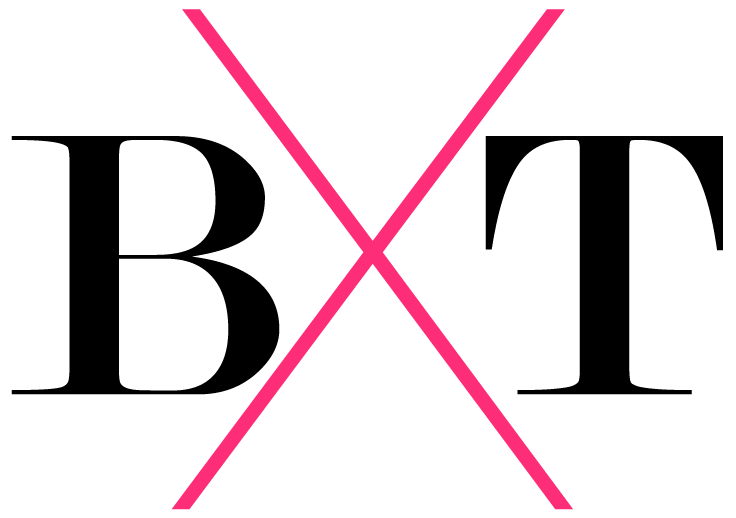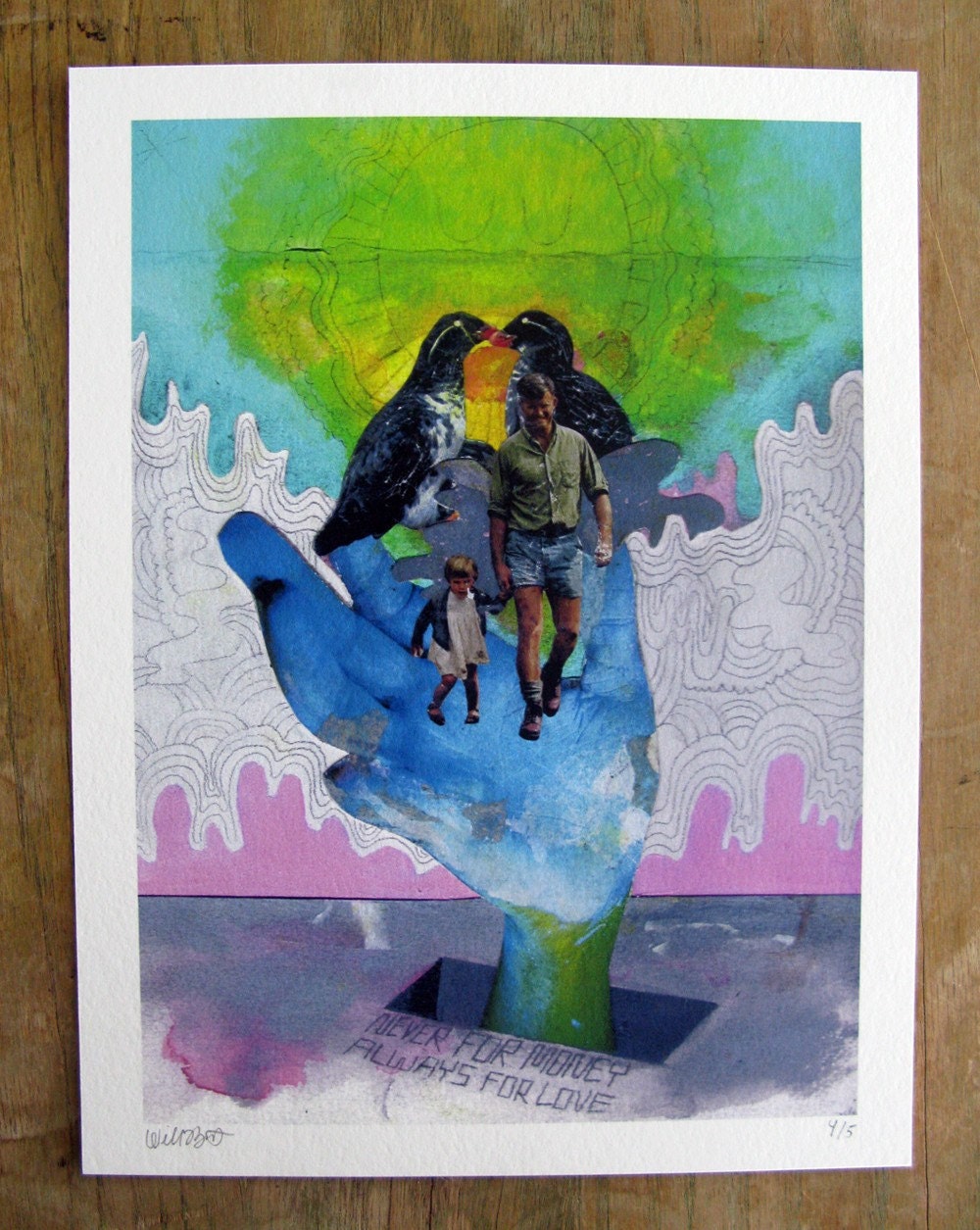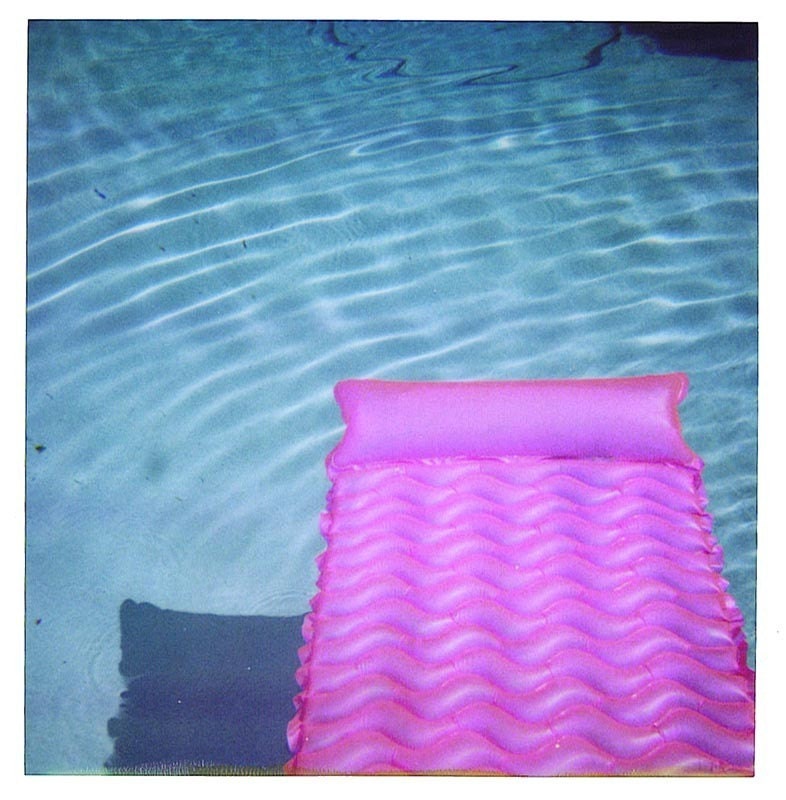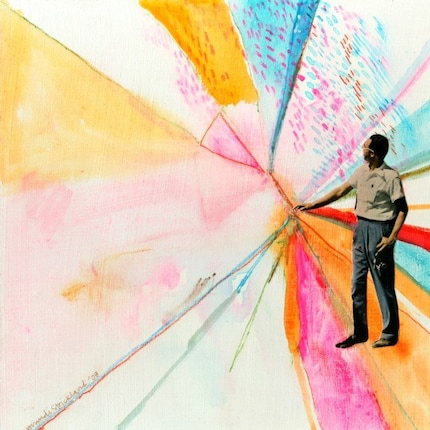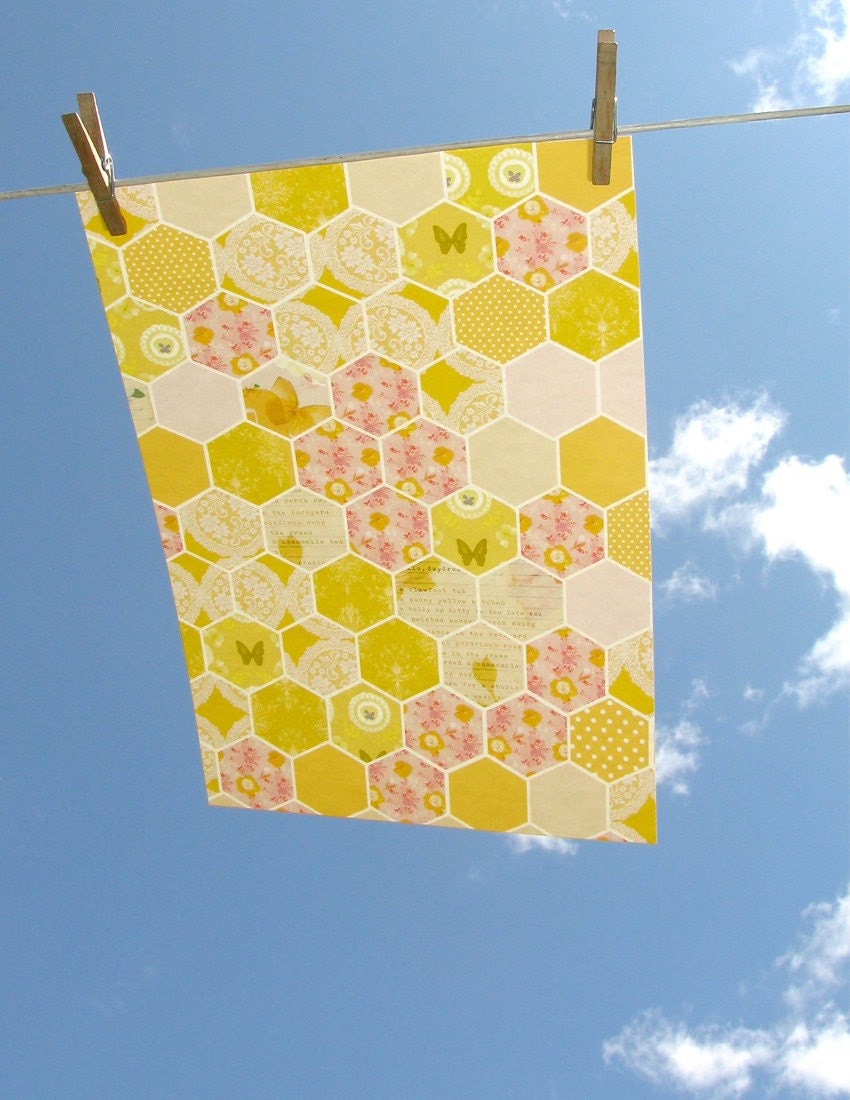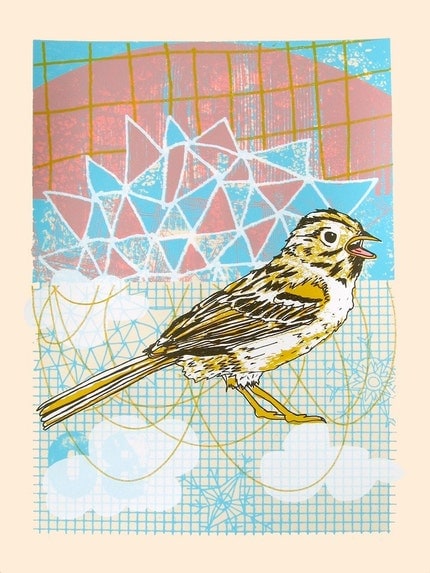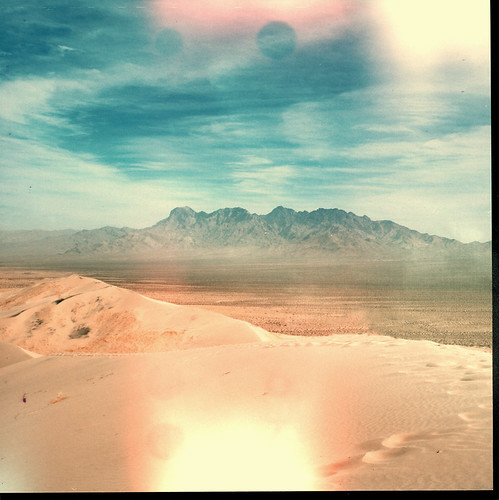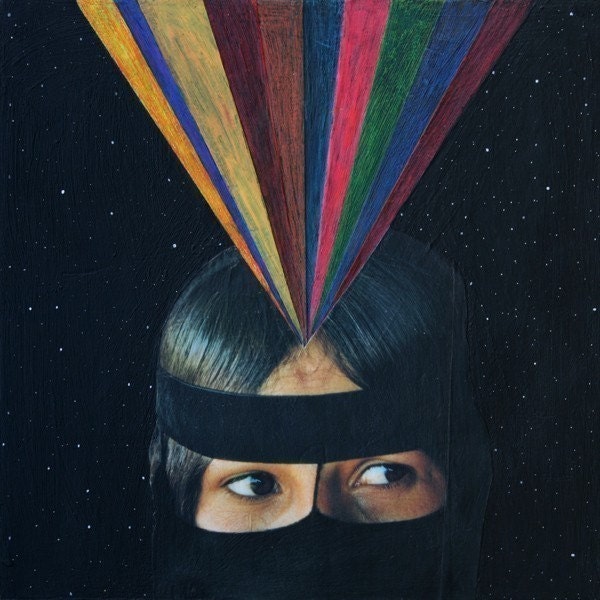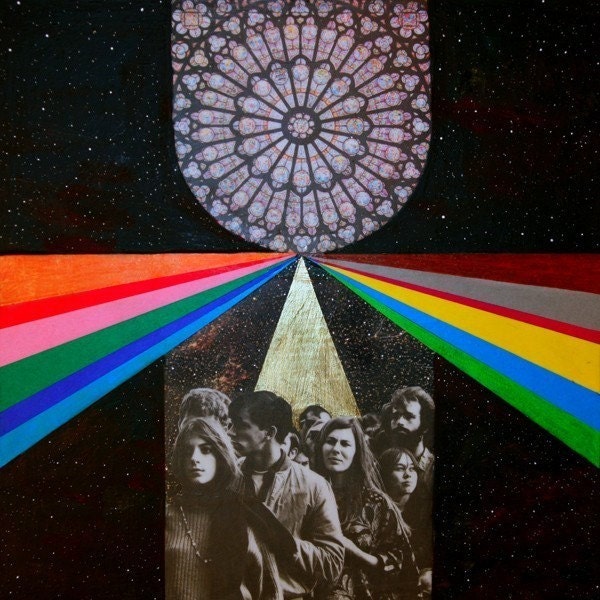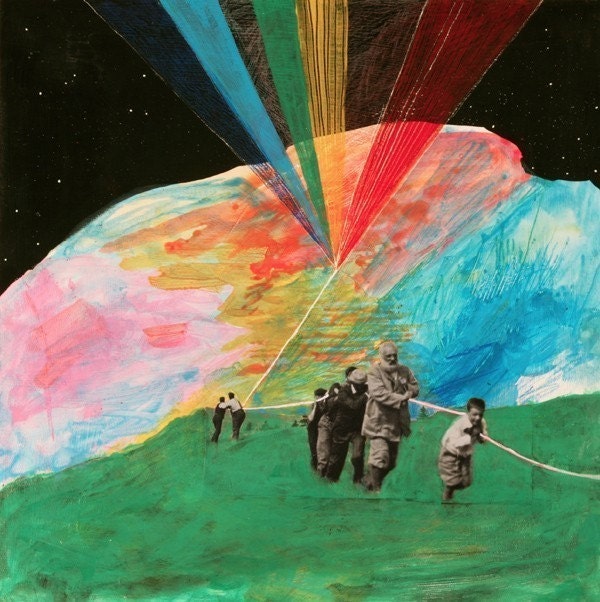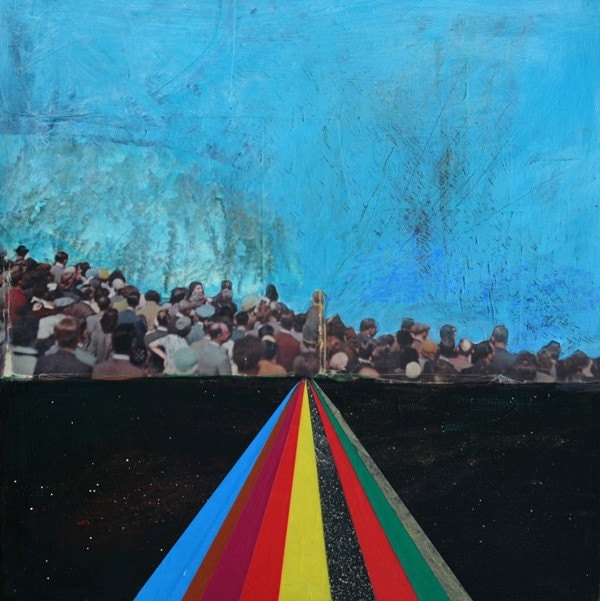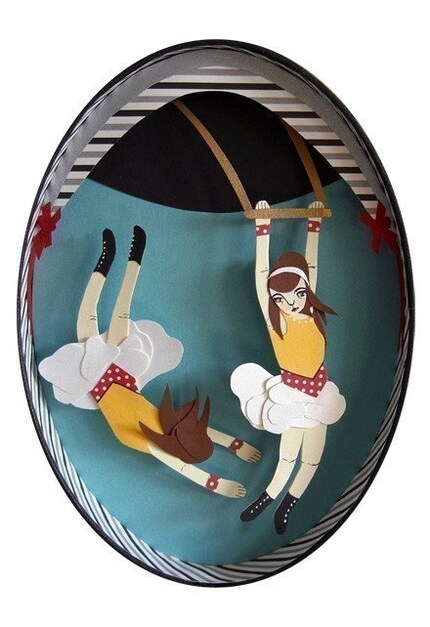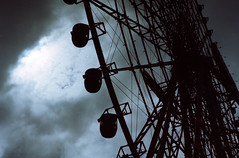Danny Heller is a Los Angeles based painter who takes the suburban territories of Southern California as his subject. Raised in the suburbs of the San Fernando Valley, Heller’s paintings reveal a sincere appreciation for the aesthetic of Mid-Century Modernist architecture and an interest in the ideals that the suburbs can represent. Heller’s paintings are exemplary in their technical merit as well as their intelligent historical orientation. However, what truly makes Heller’s paintings distinct is not only how eloquently they depict their subject or how vividly they convey a sense of place. Rather, Heller’s paintings are distinct in how they combine these attributes to express genuine affection for their subjects.
Many technical and formal aspects of Heller’s work are analogous to the physical properties of the Modernist homes depicted. Heller’s well organized compositions are elegant and economical. Forms are paired down and surfaces smoothed, even idealized. There are many long, straight lines that create a sense of dynamism that is an effective counterpoint to the many low rectangles of the Mid-Century suburban landscape. In this way Heller’s work refers to the Modern acknowledgement of the physical flatness and literal surface of a painting.
Pre-dating Modernism, Romanticism provides further context for Heller’s work. Thomas Cole’s 1836 painting commonly referred to as “The Oxbow” is a painting of a specific place that contains in its forms certain American ideals regarding the westward expansion of the time. The dark untamed left (or western) side of the painting is being encroached upon, it’s clouds chased away, by stewardship from the right (east). Human endeavor and nature are in harmonious accord. On the western shore of the river a painter depicts the scene. From the wilderness he views manicured hills and divided farmland.
While plainly stating an appreciation for the Modern American aesthetic of the mid-twentieth century, Heller’s work also draws from the Romantic tradition of landscape painting exemplified by Cole in the mid-nineteenth century. The many technical merits of Heller’s paintings are put in the service of tribute to specific places, the renderings of which are literal and scholarly in their faithfulness. Within this technical feat there is a completely un-ironic editorializing that makes Heller’s work Romantic. The tract homes are depicted in absolute harmony, both with the landscape and the physical properties of the paintings themselves; they are depicted as a fruit of the southern California landscape, never as banal or blight.
Danny Heller’s work is extraordinary in the way that it’s painted and the historical referents he employs to pay tribute to a style and a landscape for which he has affection. The paintings replace sentimentality with a studied homage; they not only depict locales but also convey ideals that extend throughout the history of painting.
See more of Danny Heller’s paintings at http://dannyhellerart.com
Thursday, August 27, 2009
Wednesday, August 26, 2009
papernstitch
This month Bees and Trees will be showing on a curated site called papernstitch. It's a great site that features fine art, home goods, and even a bit of clothing. We're really excited to be showing there, so drop over and check us out!
Labels:
Our Art

Tuesday, August 25, 2009
Get It While You Can
It's about a month until summer is officially over, but I can feel fall already. Maybe it's the altitude.
Labels:
Bees,
Featurettes

Thursday, August 20, 2009
Ben Pederson- Featured Artist
Based in Grand Rapids, MI, Ben Pederson is a multi-media artist whose work includes, but is not limited to, sculpture, sound installation and video. Pederson’s videos exemplify the concerns that run throughout all of his work. Issues of identity, transformation, media and humor are dealt with in a patently surreal manner.
The complexity of Pederson’s video work is often located in their humorous aspect. The videos employ humor to indicate the pain and sorrow from which it is often born. There is an aggressive edge and a dark tone to even the funniest moments of Pederson’s videos. The videos are ironic without being cynical, humorous while far from being jokes.
Bruce Nauman’s 1987 “Clown Torture” video provides a comfortable context for Pederson’s videos. In Nauman’s work, as in Pederson’s, humor and video itself are referents, ideas by which identity and performance relate. Pederson often appears in his videos in thin guises performing in an absurd way. In such work it is suggested that the self is a mediated entity, a product of high and low culture. Identity is formed, and transformed, through the performance of adapted routines.
Pederson employs a garish aesthetic and a discordant conflation of media to a disorienting effect. Images and scenes drawn from a broad scope of mainstream, mass media collide with no evident formal or conceptual link. Given this technique, one of the great feats of Pederson’s videos is that they do not seem random or arbitrary, but instead well orchestrated to create a unique and immediately felt sensation in the viewer. A poetic sense of rhythm provides cohesion and movement in the videos, which often end in a very different place than they begin. As in the most effective works of surrealism, Pederson creates space in his videos where expectations are subverted, new associations and new intellectual territories are discovered.
While avoiding sentimentality, Pederson is able to expresses genuine affection for the subjects that are manipulated and distorted in his videos. Likewise he avoids cynicism as he deftly maneuvers through the glut of mainstream culture to create works that are at times as dark as the corners of the subconscious. Sitcoms, pop stars and highbrow concepts, blended in Pederson’s videos, create disorienting, conflicting emotions that speak more accurately to the human experience than any one of them on their own.
Check out Ben's New Blog
The complexity of Pederson’s video work is often located in their humorous aspect. The videos employ humor to indicate the pain and sorrow from which it is often born. There is an aggressive edge and a dark tone to even the funniest moments of Pederson’s videos. The videos are ironic without being cynical, humorous while far from being jokes.
Bruce Nauman’s 1987 “Clown Torture” video provides a comfortable context for Pederson’s videos. In Nauman’s work, as in Pederson’s, humor and video itself are referents, ideas by which identity and performance relate. Pederson often appears in his videos in thin guises performing in an absurd way. In such work it is suggested that the self is a mediated entity, a product of high and low culture. Identity is formed, and transformed, through the performance of adapted routines.
Pederson employs a garish aesthetic and a discordant conflation of media to a disorienting effect. Images and scenes drawn from a broad scope of mainstream, mass media collide with no evident formal or conceptual link. Given this technique, one of the great feats of Pederson’s videos is that they do not seem random or arbitrary, but instead well orchestrated to create a unique and immediately felt sensation in the viewer. A poetic sense of rhythm provides cohesion and movement in the videos, which often end in a very different place than they begin. As in the most effective works of surrealism, Pederson creates space in his videos where expectations are subverted, new associations and new intellectual territories are discovered.
While avoiding sentimentality, Pederson is able to expresses genuine affection for the subjects that are manipulated and distorted in his videos. Likewise he avoids cynicism as he deftly maneuvers through the glut of mainstream culture to create works that are at times as dark as the corners of the subconscious. Sitcoms, pop stars and highbrow concepts, blended in Pederson’s videos, create disorienting, conflicting emotions that speak more accurately to the human experience than any one of them on their own.
Check out Ben's New Blog
Labels:
Featured Artists,
Trees

Tuesday, August 18, 2009
Friday, August 14, 2009
The Ghost, The Beast, The Chief, The Hawk, (Part 2)
“LSD is the bomb.” – Sgt. Joe Friday
Justin, over at Siempre La Luna, has composed a brilliant piece of music based on “The Ghost, The Beast, The Chief, The Hawk.” Refreshingly, his composition bears exactly none of the stereotypical earmarks of “acid rock,” and as a result it captures the para-linguistic nature of the LSD experience perfectly. But it doesn’t stop there.
I am absolutely astounded by the way in which Justin’s composition, also entitled “The Ghost, The Beast, The Chief, The Hawk,” provides such a suitable audio aspect to an idea that I evoked visually with my mandalas. An essential dimension now exists in Justin’s composition for describing the archetypal symbology present in “The LSD Story” episode of Dragnet. Do yourself a favor and go over to Siempre La Luna and read all about the conceptual underpinnings of the music as well as the technical wherefore’s and whatnot’s of it’s composition and arrangement.
Like all of the best and most complex music, “The Ghost, The Beast, The Chief, The Hawk” rewards repeated, and detailed, listening. Genius in its conception, expert in its execution and eloquent in its evocative capabilities, “The Ghost, The Beast, The Chief, The Hawk” will likely provide you with the most transcendent experience of your day. An MP3 of this sonic gem is downloadable at Siempre La Luna.
In order to keep things in (ahem) proper perspective, and to give Jack Webb his due, here are a few words from Joe Friday. Be safe, kids.
Justin, over at Siempre La Luna, has composed a brilliant piece of music based on “The Ghost, The Beast, The Chief, The Hawk.” Refreshingly, his composition bears exactly none of the stereotypical earmarks of “acid rock,” and as a result it captures the para-linguistic nature of the LSD experience perfectly. But it doesn’t stop there.
The Ghost, The Beast, The Chief, The Hawk
I am absolutely astounded by the way in which Justin’s composition, also entitled “The Ghost, The Beast, The Chief, The Hawk,” provides such a suitable audio aspect to an idea that I evoked visually with my mandalas. An essential dimension now exists in Justin’s composition for describing the archetypal symbology present in “The LSD Story” episode of Dragnet. Do yourself a favor and go over to Siempre La Luna and read all about the conceptual underpinnings of the music as well as the technical wherefore’s and whatnot’s of it’s composition and arrangement.
Like all of the best and most complex music, “The Ghost, The Beast, The Chief, The Hawk” rewards repeated, and detailed, listening. Genius in its conception, expert in its execution and eloquent in its evocative capabilities, “The Ghost, The Beast, The Chief, The Hawk” will likely provide you with the most transcendent experience of your day. An MP3 of this sonic gem is downloadable at Siempre La Luna.
In order to keep things in (ahem) proper perspective, and to give Jack Webb his due, here are a few words from Joe Friday. Be safe, kids.
Thursday, August 13, 2009
Humphrey Bilger - Featured Artist

On the Shore 2007, 26 x 40", Watercolor and Gouache on Paper
New York City based painter Humphrey Bilger makes work that mingles representation and abstraction. His paintings deal with the relative nature of experience, and the subjective challenges of representation. Using photographs as the starting point for his compositions, Bilger alters the original image to create works that are mysterious and evocative. His process of alteration is a metaphor for visual experience.
Alluding to the myriad individual filters that mediate visual experience, the photographic source material of Bilger’s paintings is integrated into a network of abstract, elegant line work. The abstract layer, which can be seen to represent the neurological filters of experience, is frequently based upon ply wood grain and raster dots— physical properties of the materials Bilger uses to make his paintings.Such properties are generally taken for granted and “invisible” in utilitarian service. With this weaving of different levels of visual information Bilger’s photographic source becomes anything but utilitarian, as an illustration would be, and instead takes on a hallucinatory, highly subjective quality.
Bilger’s pictorial subject matter is largely drawn from the natural world. Images that relate to the landscape of the desert and the body abound. Asserted by the paintings is the idea that a combination of neurological processes and environmental factors provide the basis of subjective experience. There is a dry quality to Bilger’s work. Colors are de-saturated and the desert landscapes emphasize rocks and mounds. The bodily equivalent is bone. The analogy is gracefully displayed in “We’re Here.” Another analogy, between the vast desert and the vast inner-space of the mind, is evident in Bilger’s work.
As a counterpoint to the dark and dry aspect of these paintings there is a fluid quality. The abstract line work is quite eloquent in it’s relationship to the representational aspects of the paintings. The line work evokes vascular pathways in “Brothers” and veins of ore in “Mohave.” Literal interpretations in this regard are reductive and unnecessary, however possible. On another level, the abstract, fluid nature of Bilger’s work indicates the infinite and variable combinations of sensory input and neurological filtering by which to interpret the world. That such possibilities exist is at once a liberating and terrifying prospect.
Like Andy Warhol’s morbid “Electric Chair” and “Car Crash” paintings, Bilger’s paintings create a disquieting distance between their ostensible subject matter and a typical access and interpretation of the subject. The new context, intention, formal qualities and artistic processes in both Warhol’s and Bilger’s work all become part of the meaning of the artwork. The meaning does not merely reside in identifying that which is depicted.
See more of Humphrey Bilger’s work at www.humphreybilger.com
Labels:
Featured Artists,
Trees

Tuesday, August 11, 2009
High Desert, Part II
The desert is a natural extension of the inner silence of the body. If humanity's language, technology, and buildings are an extension of its constructive faculties, the desert alone is an extension of its capacity for absence, the ideal schema of humanity's disappearance. - Jean Baudrillard, America
Labels:
Bees,
Featurettes

Sunday, August 9, 2009
The Ghost, The Beast, The Chief, The Hawk (Part 1.5)

After my recent revelation, I decided to make another one of these Dragnet/LSD mandalas. I figured that knowing what I was doing would help and that I could now make the work with a little more intention. I'm reasonably pleased with the outcome.
Thursday, August 6, 2009
Brandi Strickland - Featured Artist
Pink Floyd provide a framework for a discussion of Brandi Strickland’s collage work. From her studio in Charlotte, NC, Strickland makes collages that bridge Hipgnosis designed album covers from the hazy, halcyon days of prog rock and a sixth grade social studies book from 1972. Her work has the exuberance of someone who has just the listened to The Dark Side of the Moon through headphones for the first time. This excitement is balanced by the ambiguity of the first inklings of metaphysics, and the apprehension of opening the mind to darker depths. Recognizing that such a balance exists, and describing it in so striking a manner, Strickland’s work is highly thoughtful indeed.
“Let There be More Light” is the title of an ominous, minor key number from Pink Floyd’s 1968 album A Saucerful of Secrets, and a conceit of Strickland’s work. In subsequent years Pink Floyd would hone their ability to mingle dirge-like chunks of fuzz and lilting, pastoral melodies. The lyrical content turned to themes of work and banality, offered in contrast to the prevalent themes of outer space and innerspace, astral voyage and astral projection. Such themes and contrasts are deftly blended in Strickland’s collages.
Strickland’s collages are immediately striking. Radiant beams cross broad areas of formless dark. Hard-edged shapes and color carve the picture plane into tectonic plate-like slabs. Visually, there is a dynamic interplay of powerful forms. Human subjects people the fields of these strong shapes. Alone or together, they make contact with prismatic beams of color that invariably spread out toward the edge of the image.
Within a historical context determined by the work that Strickland’s most resembles, her collages depict the expanding consciousness as moments of balance, points where horror and reverie are the cost and benefit of searching for more meaning, more light. Her work reminds that this quest for illumination can be scientific as well as spiritual. Any type of search for meaning requires a degree of faithfulness to stories, rituals and traditions.
In Strickland’s collages, there are many visual allusions to The Eye of Providence, which has spiritual meaning, but also associations with control and authority. Depending on whom you ask, the eye in the triangle represents a benevolent God watching over all, or a nefarious secret society of Illuminati. In any regard the triangles radiating light from their pinnacles suggest illumination.
The illumination, or higher spiritual states in Strickland’s work are achieved through ritual and endeavor. There are neutral expressions on the faces of the subjects. They could be performing joyless penance, or possessed of a blissful state of non-attachment earned by meditation, or deep immersion in their work.
The palpable tension in Strickland’s collages come not just from the literal balance of dark and light but the assertion that transcendence can only be conceived of in terms of toil, struggle and a dogged faithfulness to an abstract. Such faithfulness is as likely to yield ecstatic communion with the divine as much as doubt, fear and isolation. Brandi Strickland’s collages depict the quest for illumination, harrowing and exhilarating by turns, with noble and thoughtful grace.
See more of Brandi Strickland's work >>>
brandi strickland on etsy
paperwhistle shop
brandi strickland blog
“Let There be More Light” is the title of an ominous, minor key number from Pink Floyd’s 1968 album A Saucerful of Secrets, and a conceit of Strickland’s work. In subsequent years Pink Floyd would hone their ability to mingle dirge-like chunks of fuzz and lilting, pastoral melodies. The lyrical content turned to themes of work and banality, offered in contrast to the prevalent themes of outer space and innerspace, astral voyage and astral projection. Such themes and contrasts are deftly blended in Strickland’s collages.
Strickland’s collages are immediately striking. Radiant beams cross broad areas of formless dark. Hard-edged shapes and color carve the picture plane into tectonic plate-like slabs. Visually, there is a dynamic interplay of powerful forms. Human subjects people the fields of these strong shapes. Alone or together, they make contact with prismatic beams of color that invariably spread out toward the edge of the image.
Within a historical context determined by the work that Strickland’s most resembles, her collages depict the expanding consciousness as moments of balance, points where horror and reverie are the cost and benefit of searching for more meaning, more light. Her work reminds that this quest for illumination can be scientific as well as spiritual. Any type of search for meaning requires a degree of faithfulness to stories, rituals and traditions.
In Strickland’s collages, there are many visual allusions to The Eye of Providence, which has spiritual meaning, but also associations with control and authority. Depending on whom you ask, the eye in the triangle represents a benevolent God watching over all, or a nefarious secret society of Illuminati. In any regard the triangles radiating light from their pinnacles suggest illumination.
The illumination, or higher spiritual states in Strickland’s work are achieved through ritual and endeavor. There are neutral expressions on the faces of the subjects. They could be performing joyless penance, or possessed of a blissful state of non-attachment earned by meditation, or deep immersion in their work.
The palpable tension in Strickland’s collages come not just from the literal balance of dark and light but the assertion that transcendence can only be conceived of in terms of toil, struggle and a dogged faithfulness to an abstract. Such faithfulness is as likely to yield ecstatic communion with the divine as much as doubt, fear and isolation. Brandi Strickland’s collages depict the quest for illumination, harrowing and exhilarating by turns, with noble and thoughtful grace.
See more of Brandi Strickland's work >>>
brandi strickland on etsy
paperwhistle shop
brandi strickland blog
Labels:
Featured Artists,
Trees

Tuesday, August 4, 2009
Amused
Written by Chuck Barris of "The Gong Show" fame, "Palisades Park" was the inspiration for today's group.
Amusement Parks U.S.A. - The Beach Boys
Roller Coaster - 13th Floor Elevators
Labels:
Bees,
Featurettes,
Trees

Monday, August 3, 2009
The Ghost, The Beast, The Chief, The Hawk
“ ‘C’est la vie,’ say the old folks, ‘it goes to show you never can tell.’ ” –Chuck Berry
On January 12, 1967, Jack Webb brought Dragnet blazing back to the small screen in a new incarnation, re-vamped for the times-- Dragnet 1967. The first episode was “The LSD Story,” and it is perhaps the most famous episode of Dragnet ever.
Dragnet 1967, and particularly “The LSD Story,” is part of the media acid panic of the late 1960’s. At once creating fear and mystique, there was much hysterical rhetoric around LSD. Driven into the black market, and thus the mainstream, when it was officially prohibited on the ominous date October 6, 1966, acid was hot on the cultural radar, titillating the teenagers and scaring their parents. The implications of this, and other fascinating acid conspiracies, are well examined in Martin A. Lee and Bruce Shlain’s book Acid Dreams.
“The LSD Story” was directed and written by Jack Webb himself (he was credited as John Randolph), and as in every Dragnet episode he portrayed Sgt. Joe Friday. Among some other pretty wild assertions in “The LSD Story” Joe Friday gives “the ghost, the beast, the chief and the hawk” as “acid freak” parlance for LSD.
 The ghost, the beast, the chief, the hawk.
The ghost, the beast, the chief, the hawk.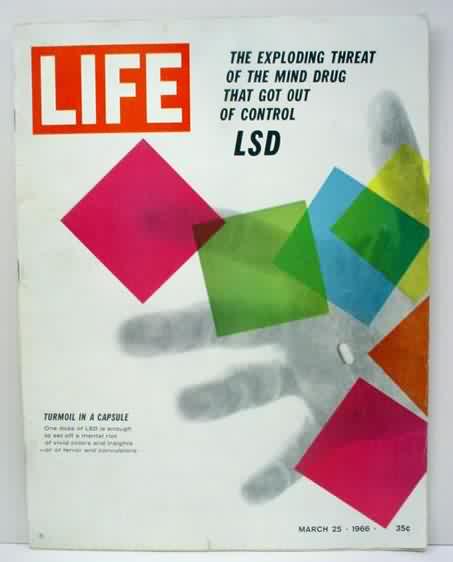 Those words, all having dark and/or authoritarian connotations, sound a minor key against the subject of LSD. They are a creepy counterpoint to the brightly colored and Baroque language typically associated with the acid experience. Ghost, beast, chief and hawk are effective poetic choices in this way, but they have a meaning beyond their formal aspect.
Those words, all having dark and/or authoritarian connotations, sound a minor key against the subject of LSD. They are a creepy counterpoint to the brightly colored and Baroque language typically associated with the acid experience. Ghost, beast, chief and hawk are effective poetic choices in this way, but they have a meaning beyond their formal aspect.These terms have a corollary in ancient symbology as the angel (ghost), the lion (beast), the bull (chief) and the eagle (hawk). The angel, lion, bull and eagle are mentioned specifically in the Old Testament of the Bible. They are mentioned too in the book of Revelation, and they are associated with the four authors of the Gospels in the New Testament: Matthew-- the angel, Mark-- the lion, Luke-- the bull, John--the eagle.
The angel, lion, bull and eagle appear on the Tarot cards “The World” and “The Wheel”—they surround the world, and the wheel.
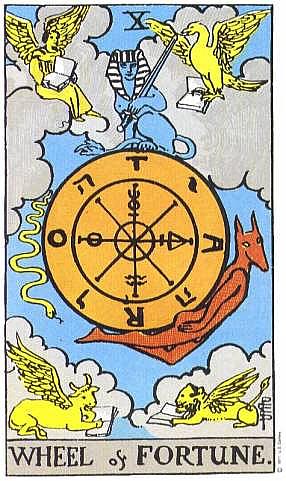
 A sphinx, such as the famous one in Giza, appears to be a morphological combination of these symbols.
A sphinx, such as the famous one in Giza, appears to be a morphological combination of these symbols.The symbols are associated with the four elements (angel-water, lion-fire, bull-earth, eagle-air), and analogous to the Zodiac signs Libra, Leo, Taurus and Scorpio.
The angel, lion, bull, and eagle are used to symbolize four extreme personality types in Robert Anton Wilson’s behavior theory described in his book Prometheus Rising.
Basically, these extremely generalized personality types are created by an orientation toward one quadrant of a matrix generated by the programming of the first two neurological circuits of the mind. Circuit One operates bio-survival. An animal advances toward nurturing and safety or retreats from harm (forward and back). Circuit Two controls brain functioning on the inter-personal/political level. An animal enlarges its body to dominate, or shrinks in domination by another (up and down).
 A combination of that up-down, forward-back represent four very basic “directions” for a person to go when they are pulled off center, so to speak. People can be like an angry, domineering and paranoid hawk, a stubborn, truculent bull, an easy going, passive angel, a prideful, generous lion, or some combination thereof.
A combination of that up-down, forward-back represent four very basic “directions” for a person to go when they are pulled off center, so to speak. People can be like an angry, domineering and paranoid hawk, a stubborn, truculent bull, an easy going, passive angel, a prideful, generous lion, or some combination thereof. Again, these symbols encircle a complex subject, they lie outside of the center.
The terms ghost, beast, chief and hawk were chosen by Jack Webb to name LSD.
 Whether he read them somewhere, or he heard them when he infiltrated a gang of “acid freaks,” or he made them up because they sounded good is unknown, and unimportant. In “The LSD Story” they identify LSD, the terms encircle the idea of LSD.
Whether he read them somewhere, or he heard them when he infiltrated a gang of “acid freaks,” or he made them up because they sounded good is unknown, and unimportant. In “The LSD Story” they identify LSD, the terms encircle the idea of LSD.In the past year and a half, I have occasionally made gouache works dealing with the ghost, the beast, the chief and the hawk. Always, I have made them the same way-- with the words in the four corners of radiating squares. It just felt natural to do so, and now I know why.

The Ghost, The Beast, The Chief, The Hawk, Gouache on Paper, 2009
 The work is a mandala. The center from which the colorful squares radiate is blank and roughly the size of a tab of blotter acid. This representation of an acid tab, as an empty center, the silenced ego, describes a condition commonly attributed to an acid trip. The idea of LSD is framed by four terms with ancient symbolic analogs, which name, reduce and generalize their subject.
The work is a mandala. The center from which the colorful squares radiate is blank and roughly the size of a tab of blotter acid. This representation of an acid tab, as an empty center, the silenced ego, describes a condition commonly attributed to an acid trip. The idea of LSD is framed by four terms with ancient symbolic analogs, which name, reduce and generalize their subject. All of these connections and conclusions were drawn only after I was finishing this most recent version of this work. As Joseph Campbell’s work famously points out, ancient symbols pervade even contemporary culture. Evidently they remain potent enough to communicate directly with the subconscious.
Saturday, August 1, 2009
Subscribe to:
Posts (Atom)
